In this set of CircuitousRoot "Notebooks," I aspire to write a comprehensive historical and practical technical treatise on all ways of making typecasting and linecasting matrices. This is of course an ambitous project, and while it presently has some potentially interesting content, it is very far from finished.
This treatise will have the overall logical structure of a traditional book, although it will not be formatted as one. It may be cited as a complete work by citing the URL of the present page:
http://www.CircuitousRoot.com/artifice/letters/press/typemaking/making-matrices/index.html
(Sections prefixed with "[ND]" are Not Done (at all). The absence of this prefix, though, does not imply that the section in question is actually finished.)
Preparation, on Screen and Paper:
Punchcutting by Hand in Steel:
Driving Matrices with a Hand-Powered Press:
Patrix Cutting by Hand in Soft Metal:
[ND] Electroforming Matrices from Patrices or Existing Types:
Goudy's Method of Paper Master Patterns:
[ND] Planning Working Patterns:
[ND] Mixed Pantographic and Hand Engraving of Solid Working Patterns:
Pantographically Engraving Solid Working Patterns:
[ND] Wax Plate Methods for Working Patterns:
[ND] Soldered & Riveted Working Patterns:
[ND] Non-Pantographic, Non-Hand-cut Solid Working Patterns:
Special Topics in Working Patterns:
Making Matrix Blanks for Machine Processes:
(For traditional matrix blanks, see Making Traditional Matrix Blanks in the Striking Matrices by Hand section. There is of course some overlap between hand and machine techniques.)
[ND] Pantographic Punch and Patrix Engraving:
Pantographic Matrix Engraving:
Justifying Matrices by Machine:
The Theoretical Considerations in Matrix Justification (q.v.) are the same for both justifying by hand and justifying by machine. It is of course possible to justify a machine-made matrix by hand.
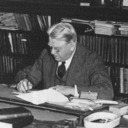
Front Matter
This is a book pretending to be a set of web pages (or perhaps it's the other way 'round), so it has all of the traditional items which come at the beginning of a book:

[ND] Orientation: The Three General Methods
Too many popular works on type-making have been written as if there was only One True Way to make matrices. There are at least three major kinds of methods, with many variations and subdivisions within each.
At times these methods interact with each other (e.g., Excursion: Refining Type Beards by (Re)electroforming Matrices ). There have also been a very few other methods (such as the direct cutting of the " sanspareil" matrices).
I'll also cover a couple of questions which are perhaps obvious (at least it should be obvious that the questions should be asked).

The Terms of Type and Matrices
If you learned about "type" digitally, much of what you know is wrong. I'm not trying to be snarky here. There are things which you need to know in order to make metal type which cannot be expressed in the vocabulary of what passes for "type" in the digital world. If you don't learn what the words really mean, you will fail.
The general method in this book is to group related activities together on a technical basis. So for example all of the methods of engraving working patterns will be gathered together (rather than being treated separately within descriptions of overall matrix making processes). This type of organization works pretty well because, unfortunately, for the most part we do not know what the overall methods of particular companies or individuals were. Too often, all that survives are snippets rather than records of an entire process: an oblique reference in an article, a resolutely silent photograph.
A number of historical sets of practices, however, were sufficiently well documented at the time that they may be treated as more-or-less coherent entities. So for example it is useful to consider Goudy's method as a whole, or Rimmer's for Stern, or ATF's 1940s methods. The chapters here discuss, briefly, each of these methods as a whole. They also present any information specific to those methods which doesn't quite fit elsewhere, and provide a list of places in the book where each aspect of these methods is discussed. Using these lists it is possible to "thread" your way through the book reading only about one particular method (Goudy's, for example).
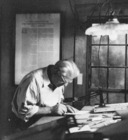
Goudy's Method
Goudy developed a distinctive method employing paper "master patterns." While this method was never used by larger commercial typefoundries or matrix makers, it has certain advantages for artisanal type-makers and it has been the basis for the work of several later matrix makers (Duensing, Rimmer).

Rimmer's Methods
Because of Richard Kegler's exceptionally good film Making Faces , which documents Jim Rimmer's updated version of Goudy's method as he used it to make the typeface "Stern," Rimmer will be remembered for his pantographic matrix engraving. Moreover, Rimmer's method for Stern remains the best starting point for the artistan matrix maker. But it would be a mistake to think that this was the only way Rimmer made type. He employed several methods over a relatively long period, and his success (and occasional failure) with these is very instructive to the aspiring matrix maker.
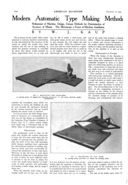
Chronology of ATF's Methods
If you start with Benton around 1883 and end with the demise of ATF in 1993, you have a business continuity of 110 years of machine-based type-making. If you include The Dale Guild, you're at 130 years as I write this in 2013, with no sign of stopping. There is much less continuity of technology, though. This is an attempt at a chronology of ATF's various methods, with pointers to further discussions (when enough is known to permit a further discussion).

[ND] ATF's 1940s Method
In the 1940s, American Type Founders developed a method which differed substantially from both their earlier and later practices. (Rehak write that this was in response to war shortages.) Although used only briefly, this method was well documented in a 1948 film, Type Speaks! It is possible, therefore, to consider it as a whole.

[ND] The Monotype Corp.'s 1950s Method
In the 1950s, The Monotype Corporation Limited (UK) made a film on their matrix making practices (and devoted a number of The Monotype Recorder to it). These are pantographic punch engraving methods for both composition and display sizes. They must therefore differ from the earlier Lanston Monotype methods for electroforming display matrices from machine cut patrices. The Monotype UK methods for wax/electroformed working patterns, on the other hand, are probably quite similar to the original Benton methods.

Early Methods for Large Matrices
Through the early 19th century several methods were used for making large matrices (which are difficult to strike using the conventional punch-based methods of the time). These were all largely forgotten, and have been reconstructed from a few surviving accounts and materials. (With the introduction of the direct cutting of wood type by pantograph in the 1830s, the need for large cast metal types declined. Later, stereotype and electrotype processes provided additional methods.) These early methods for making large metal types included:
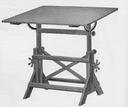
Design Sources
From a technical, not aesthetic, point of view. [This section isn't really done; I've just outlined it so that some of the links to it from other chapters will work.]

[ND] Digital Lettering and Type Formats
Technical studies of digital type formats (rare) and digital lettering formats (common).

[ND] Excursion: Digital Type and Computer-Aided Lettering
Contrary to current belief, in practical terms digital type does not presently exist (although it certainly could). Computer-Aided Lettering does exist, but it is ill-served by the misconception that it is type and that its use is "typography."
"Design drawings" can be anything the designer likes. "Finished" drawings, on the other hand, must specify not only the designs of the letterforms but also those aspects which turn lettering into type: vertical alignment relative to the type body (lining) and set width and horizontal alignment relative to the type body (fitting).
In July 2016, I was fortunate to be able to take Stan Nelson's week-long class in punchcutting, taught at Wells College (Aurora, NY) as a part of the Wells Book Arts Summer Institute. The sections here will document my attempts to do again in my own workshop what we did during that intense week.

Tools of the Hand Punchcutter in Steel
As with all fine hand tools, they are quite beautiful. This section examines these tools, each in some detail. It also presents a progressive list of punchcutter's tools in the order in which they are used (which is therefore the order in which they might be acquired).

Preparing the Punch Blank
All of the beginning steps up to the point where you are ready to transfer the design to the face of the punch blank (or draw it directly, if you're feeling bold). The examples here assume that you're making a punch from modern tool steel bar stock, not forging a punch blank by hand. Each step will be illustrated with photographs from my own shop. At each step I'll also list any tools new to that step, so that we can build up, incrementally, an overall list of tools used.
Punch forms, ancient and modern. Stock size (modern) relative to punch size. Cutting off and breaking cut edges for safety. Breaking the long edges for ease of handling. Filing the hammer end. Squaring the punch end Smoothing the sides.
Also, a short note on Moxon's forged punches and his models for them.
It is of course perfectly reasonable to justify a hand-made matrix by machine.
A "planchet" (not planchette) is the blank disk from which a coin is struck. The term has been used by extension to refer to the blank from which a matrix is struck (or in which it is electroformed, or with which it is directly engraved).

[ND] Theoretical Considerations in Matrix Justification
Surfacing matrices to depth. Lining and fitting matrices individually and within a single series. Traditional set and point set. Lining multiple series; lining standards and point body. Lining to standards; point line. Lining and fitting to related and unrelated series. Iteration of the justifying process; modifying fitting and lining; modifying letterform design.
The metal used typically was just called "metal" (when older sources meant steel, they said steel) and was a typemetal-like alloy somewhat softer and less brittle than ordinary typemetals. Brass could be used as well (when Carl Dair began learning punchcutting at Enschedé, he was given the choice of starting in typemetal, brass, or steel).
See The Issue of Patrix Cutting in Soft Metal for a discussion of the unrecognized importance of this method.

[ND] Additional Tools of the Patrix Cutter in Soft Metal
The basic kit of tools for patrix cutting in soft metal is the same as that for punch cutting in steel. But there are several additional tools specific to working in soft metal.
Popular accounts of the development of type often reduce the introduction of machine techniques in matrix making to one of Benton's vertical pantographs. It was a lot more complicated than that.
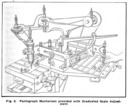
The Pantograph in Context
Distinguishing and examining pantographs of many kinds.
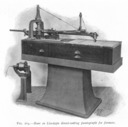
Pantographs for Making Working Patterns
A list of pantographs known to have been used for making working patterns.
[TO DO] Requirements for pantographs for use in this service.
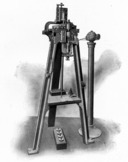
Pantographs for Making Patrices, Punches, or Matrices
[UNFINISHED!] A list of pantographs known to have been used for making patrices, punches, or matrices. So far, I've identified 23 different machines known to have been used (of several mutually distinct types), and a further dozen situations where some as yet unknown machine must have been used. [TO DO] Finish studies of individual pantographs known to have been used in this service.
[TO DO] Requirements for pantographs for use in this service.
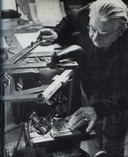
Specific Pantographs In More Detail
Identification and studies of particular pantograph engraving machines known to have been used in the practices of particular firms or individuals.
There will be some overlap between the material here and that in the three chapters above. Every pantograph listed here will also be cited above, but there I'll simply identify it whereas here I'll try, for the lesser-known machines, to collect every scrap of evidence about them. The coverage here will also be only of the machines of those makers for which a relatively well-documented set of practices survives.

Pantographs Not Suitable
Some pantograph rotary engraving machines are fine machines for their intended purposes but not suitable for use in matrix making. The relatively common "New Hermes Engravograph" in either of its two basic forms is such a machine. It is useful to understand why this is so.
The pantographs get all of the attention, but making the cutters is the hard part.
Working patterns and matrices require cutters which differ not only in matters of scale (working patterns are larger, matrices are tiny) but form. A working pattern must be followed by a tracer and may be best made with vertical edges. A matrix requires a tapered cutter to produce the beard on the type (what would be called the "draft" of the mold in non-typographical casting).
Goudy developed a method of using paper "master patterns" for pantographically engraving his working patterns. This method is better documented now than most methods. It was never used in larger-scale commercial typefoundry or matrix manufacturing operations, but it has a number of advantages for the artisanal studio.

ATF's Machine & Hand Engraved Working Patterns
Rehak describes a method employed at ATF for working patterns for direct matrix engraving (thus 1899 and after) before the introduction of wax-plate methods (in 1905) which involved the combined pantographic engraving and hand engraving of incised-outline working patterns into lead (later zinc) plates. There is much that I do not understand about this method.

Goudy's Working Pattern Blanks
He tried various materials before settling on cast typemetal.

[ND] ATF's Solid Brass Plate Working Patterns
From 1941 through 1948 ATF engraved its working patterns directly in solid brass plates using a Gorton 3-B (not 3-U) three-dimensional pantograph engraving machine stripped of its three-dimensional apparatus and operated as a rather heavy-duty two-dimensional pantograph. This is the method documented in their 1948 film Type Speaks!.

[ND] The Dale Guild's Deckel Engraving
The Dale Guild has a Deckel horizontal pantograph engraving machine in the Taylor-Hobson style. Rehak notes that is used to duplicate existing ATF solid brass patterns, but it isn't quite clear if it is used to originate new patterns from drawings.

[ND] Mergenthaler Linotype's Plaster Working Patterns
An intermediate pattern was engraved using a pantograph rotary engraving machine in solid plaster. From this the actual working pattern was made by conventional plaster stereotyping. Presumably this was an early method. It is mentioned in Legros & Grant (1916), but not Legros' 1908 paper. It is not mentioned in later Mergenthaler Linotype literature, where they seem to have adopted Barr's Soldered & Riveted working patterns.
For the most part these involve scribing a design in a wax layer on top of a substrate, electroforming a copper shell from this, and then backing up this shell with typemetal. This may have been the most widely used method of all. In addition to the practices described in the chapters below, it may be noted (from evidence in Typographical Printing Surfaces, pp. 209-210) that wax plate methods were used by:
Legros & Grant, ever inventive, describe a variation where the wax intermediate is used to cast a working pattern in cement.
All methods for making solid working patterns which do not at any time involve a pantograph (or, much rarer, cutting or engraving by hand). Typically these involve the optical projection of a design onto the working pattern blank, but that pattern blank may be of various materials and the pattern in it may be created in a number of ways.

Duensing (Nyloprint)
Paul Hayden Duensing used working patterns made from "Nyloprint" photopolymer plates. A part of the reason he did this was to accomodate the relatively small working pattern sizes allowed by his Preis engraving machine.

Multi-Part Working Patterns
Legros (in 1908 and 1916) describes two methods for making composite working patterns to allow accents to be added to regular characters without cutting separate accented characters for each accented sort required.

Cryptic References Concerning Working Patterns
One runs across occasional remarks concerning working patterns which don't quite seem to fit anywhere (yet). Some of these identify entire manufacturing processes not yet described. Here are those I've found so far.
(For traditional matrix blanks, see the "hand punchcutting" section)

Goudy's Matrix Blanks
Very little is known about them, and nothing is known about the ways in which he made them.
The Theoretical Considerations in Matrix Justification (q.v.) are the same for both justifying by hand and justifying by machine. It is of course possible to justify a machine-made matrix by hand.

Goudy's Matrix Justifying
As usual, Goudy's methods were his own. They would be impossible for comprehensive matrix production at firms such as ATF or Mergenthaler Linotype, but they may well suit the contemporary small-scale matrix maker.
As more is learned of these methods, it is likely that many of them should be moved into the main text above.

[ND] The Sanspareil Matrices
18th century direct, non-pantographic cutting of large matrices by the predecessors of Stephenson, Blake.

[ND] Rogers' "Riverside Caslon"
While at the Riverside Press, Bruce Rogers modified existing Caslon types (14 pt lowercase and 12 pt capitals) with a graver, and then had matrices electroformed from them. Sources: Warde, Frederic. "On the Work of Bruce Rogers." Originally in The Fleuron [which issue?]; reprinted in Fleuron Anthology, see p. 143. He also tightened up the set (I presume that this must have been done by specifying horizontal alignment for the matrix making and desired set for the casting, rather than physically altering the pattern types).

Appendix: How Long Did It Take?
How long did it take to make a typeface?
All portions of this document not noted otherwise are Copyright © 2008-2013 by David M. MacMillan and Rollande Krandall.
Circuitous Root is a Registered Trademark of David M. MacMillan and Rollande Krandall.
This work is licensed under the Creative Commons "Attribution - ShareAlike" license. See http://creativecommons.org/licenses/by-sa/3.0/ for its terms.
Presented originally by Circuitous Root®